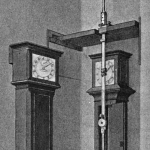Background
Henry Kater was born on April 16, 1777, in Bristol, England. He was the son of Henry Kater, a sugar baker, and his wife, Anne Collins. The father died in 1794.

1808
Haig Rd, Royal Military Academy, Camberley GU15 4PQ, England
Kater's higher education was confined to a brief period, when he was thirty-one, at the Royal Military College at Sandhurst.
1815
Royal Society, London, England
In 1815 Kater was elected a fellow of the Royal Society.
1817
London, England
Kater won the Copley Medal in 1817 for his pendulum experiments.
1817
London, England
Kater's pendulum. It was invented by Kater in 1817.
1831
London, England
In 1831 Kater received the Gold Medal of the Royal Astronomical Society.
Royal Swedish Academy of Sciences, Stockholm, Sweden
Kater was a member of the Royal Swedish Academy of Sciences.
American Academy of Arts and Sciences, Cambridge, Massachusetts, United States
Kater was a fellow of the American Academy of Arts and Sciences.
A drawing of Henry Kater.









Henry Kater was born on April 16, 1777, in Bristol, England. He was the son of Henry Kater, a sugar baker, and his wife, Anne Collins. The father died in 1794.
Kater was encouraged by his father to become an attorney, but after his death he abandoned his legal training and served with the British army in India. His higher education was confined to a brief period, when he was thirty-one, at the Royal Military College at Sandhurst.
Kater entered the army, obtaining a commission in the 12th Regiment of Foot, then stationed in India, where he assisted William Lambton in the Great Trigonometric Survey. Failing health obliged him to return to England. Shortly afterwards he was promoted to the rank of captain. In 1814 he retired on half-pay, and devoted the remainder of his life to scientific research. After 1815 Kater became active in the Royal Society’s affairs; he served on its council and as vice-president, and was the first scientist to become treasurer.
On the basis of the principle enunciated by Huygens that the centers of suspension and oscillation are interchangeable, Kater devised a reversible pendulum (which became known as “Kater’s pendulum”) with knife edges accurately adjusted to lie at the conjugate points. By using the distance between these points as the “length” in the formula for a simple pendulum, he was able to determine with great accuracy the length of a pendulum beating seconds under specified conditions. He thereby obtained accurate values for g, the acceleration due to gravity, at several stations of the Trigonometrical Survey of Great Britain and estimated the ellipticity of the earth. Kater performed these experiments as a member of a committee appointed by the Royal Society in response to a request by the government for assistance in standardizing weights and measures.
He also contributed to the improvement of telescopes by devising floating collimators, and in 1821 he reported the appearance of volcanic action on the moon. His experiments on the relative illuminating powers of Cassegrainian and Gregorian telescopes led him to conjecture on the nature of light (1813). It was one of his rare ventures into the realm of theory.
He is considered as the inventor of the prismatic compass, patented a year later by Charles Schmalcalder. He also studied compass needles, his Bakerian lecture containing the results of many experiments. The treatise on "Mechanics" in Dionysius Lardner's Cabinet Cyclopedia was partly written by him.

Henry Kater went down in history as a prominent scientist and inventor. His most significant scientific contributions consisted of improvements in geodetic instruments, refinements of geodetic measurements, and in the standardization of weights and measures. His reversible pendulum was used for absolute measurements of gravity until the 1950s.
He won the Copley Medal in 1817 for his pendulum experiments. In 1831 he received the Gold Medal of the Royal Astronomical Society.
In 1815 Kater was elected a fellow of the Royal Society. He was also a member of the Royal Swedish Academy of Sciences and fellow of the American Academy of Arts and Sciences.
It is not known for sure whether Kater was married or not.
